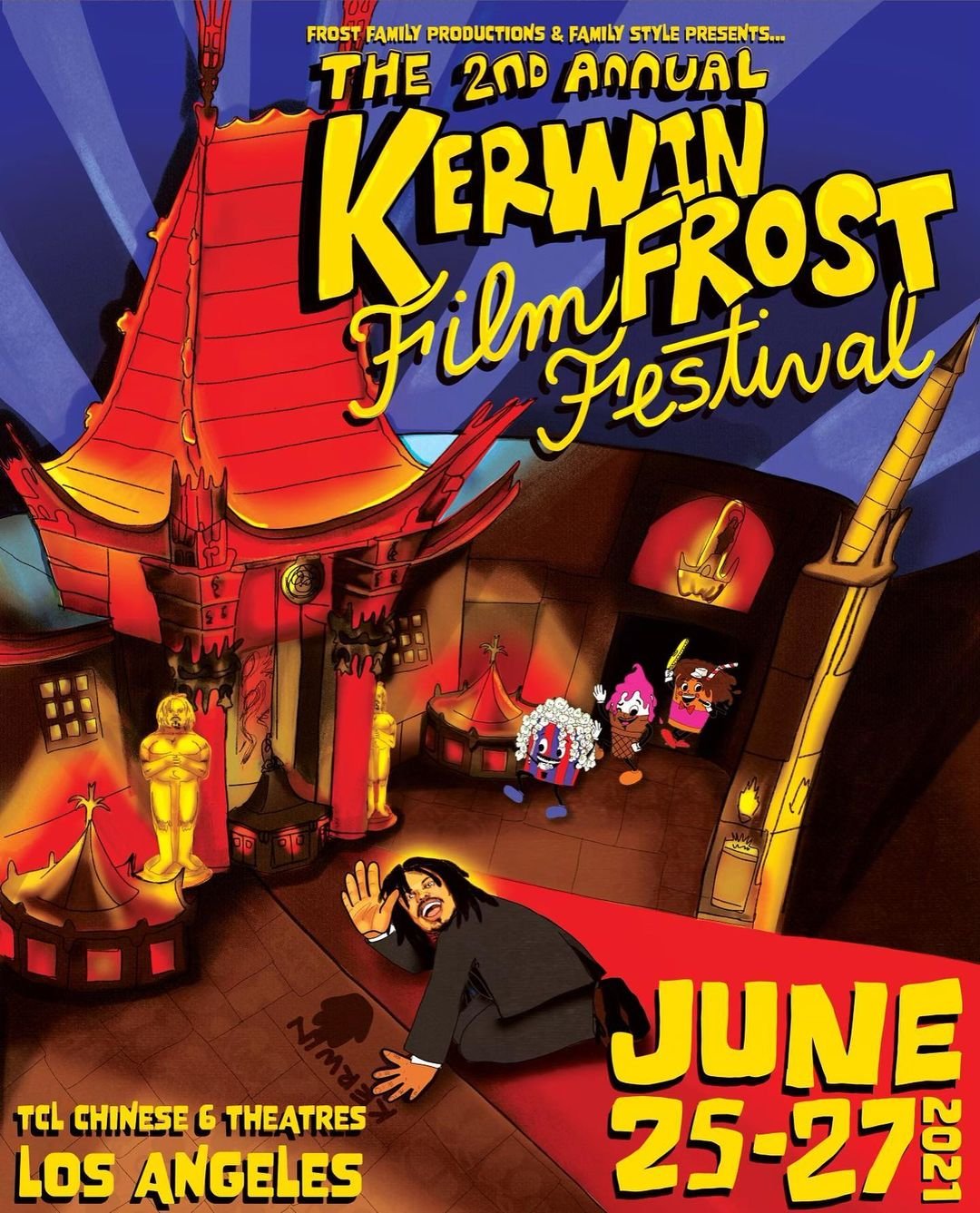Devin N. Morris finds memories attached to the materials of domestic space
The multidisciplinary artist, originally from Baltimore, Maryland, sits down with writer and curator Teri Henderson.
This story was originally published in Justsmile Issue 1 FW20.
Photography Don Brodie
Text Erin McFadyen
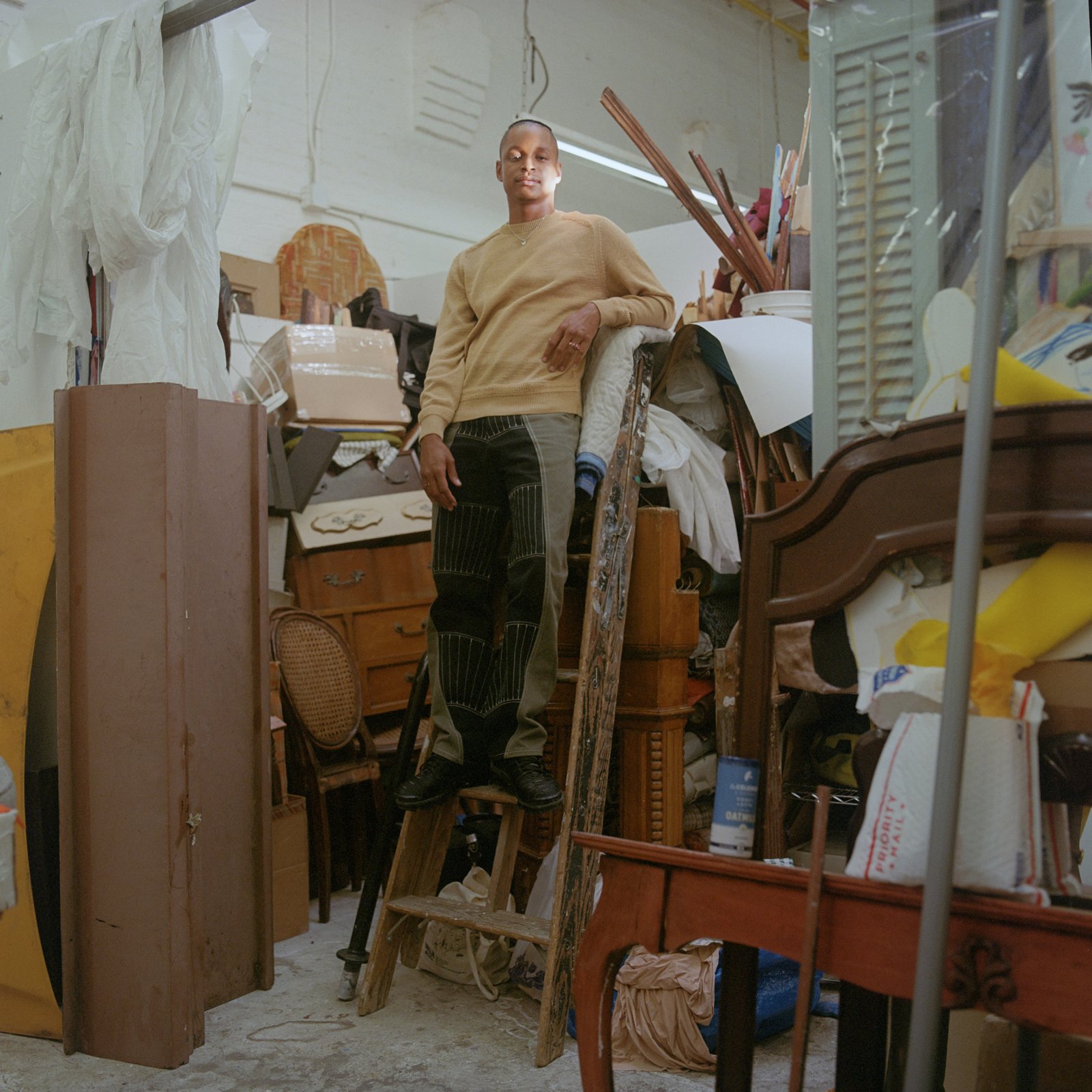
Morris in his studio photographed by Don Brodie
Across installation, video, mixed media paintings, and collage, Devin N. Morris takes us into surreal, fluid spaces of intimacy. Re-drawing the dimensions of the domestic both visually and conceptually, Morris has devoted his practice to the imagining of histories, presents, and futures of kinship which might both exist within and challenge the norms of American social life. Morris’s work often turns around gestures of kindness, vulnerability, and innocence, and he sets men’s closenesses especially — whether platonic or otherwise — in celebratory light.
Much of Morris’s work is inspired by his youth as a Black youth in Baltimore, MD, as well as his experiences navigating the world as a queer Black man. Often, he finds, memories attach themselves to the materials of domestic space; they weave themselves into upholstery, curtains, furnishings. Rearranging these materials of tradition as he sees fit, Morris recasts the family into a plethora of possible shapes, positing imaginary stories of our cultural past as tools with which to imagine different possible futures.
Morris is also the founder and editor for the collaborative 3 Dot Zine. Writer and curator Teri Henderson speaks with him for Justsmile.
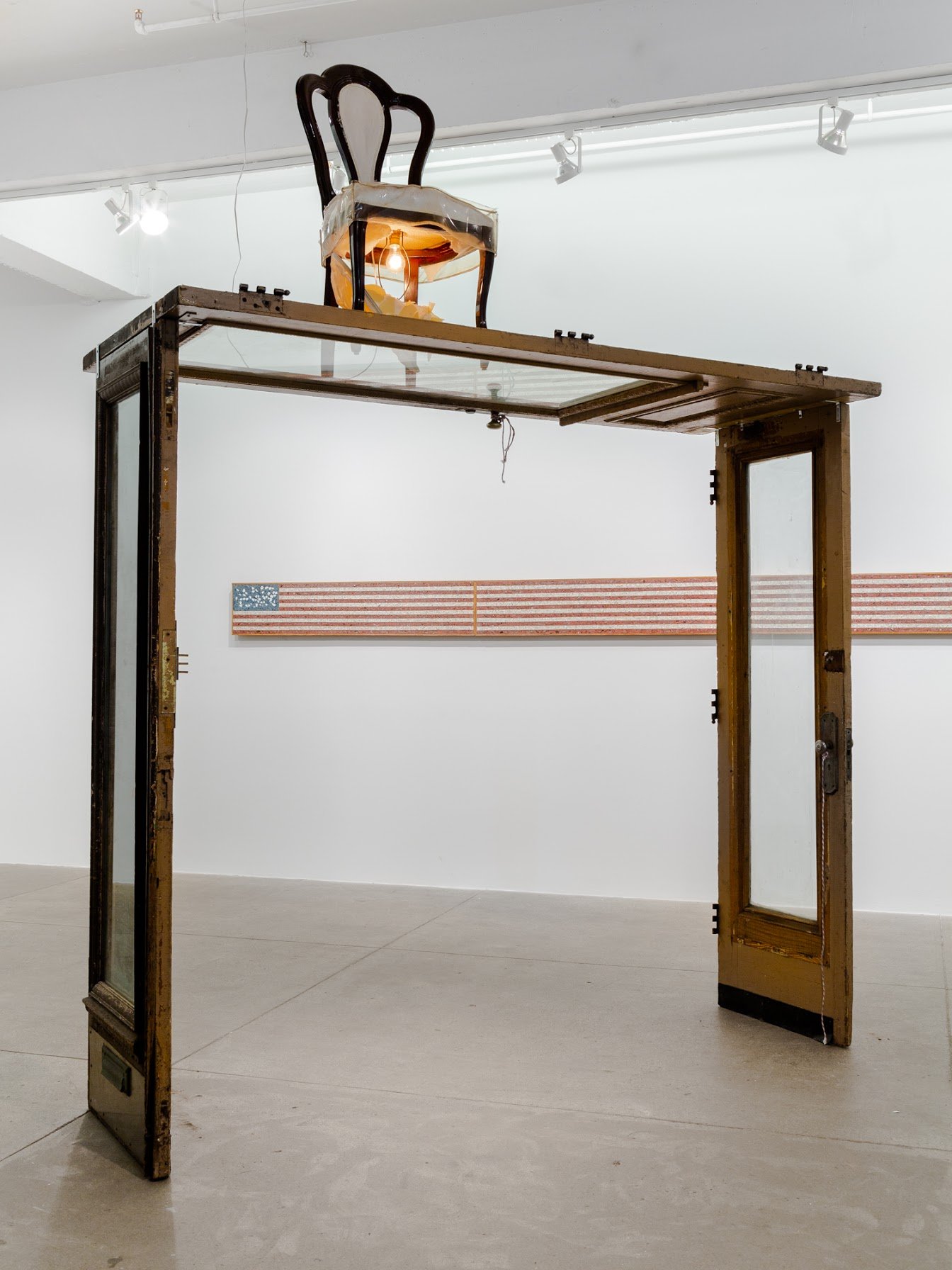
Devin N. Morris 'Moving away from up there. Broken easily as brown skin does walking through brown stone. From Somewhere and Me at the base of stairs treading rows perfectly soiled for blossoming lunacy', 2020
Teri Henderson: I’ve been a fan of your practice for years, and I was honored when you agreed to be part of my first solo gallery exhibition, ANOTHER COUNTRY. This was the last show at Terrault Contemporary, which is incidentally where you held your first solo show, In a Dignified Fashion. So, when I installed your work in Terrault for ANOTHER COUNTRY, it felt like a full circle moment; like coming home. It’s so nice to have time to speak with you again now. So let’s get into it. What are artists for?
Devin N. Morris: I think to find out what artists are for, you ask people who are affected by art.
An artist is someone who helps translate wonder, or it could be even more pointed and not wondrous, it can just be something that's factual or personal.
But art will kind of transport you into this gray, nebulous space that almost feels spiritual in whatever direction it's going toward. It doesn't always have to be direct.
Sometimes art feels like that. For me it feels like artists might be for channeling messages. Artist channel messages. And then -
TH: Then people receive them.
DNM: Receive them, yeah.
TH: Do you consider yourself a poet?
DNM: I think I kind of consider myself playful. I think about poetry; how I might like or dislike poetry, for whatever reason, and then kind of utilize elements of it and the way I write or think.
TH: The way that you use words -- it's just, it's beautiful. Sometimes I read artists' work. and I don't know what the fuck they're saying…
DNM: Yes. I'm not trying to prove anything. I'm just trying to translate how I feel.
TH: I think that even before we met, I knew about 3 Dot Zine. Are you still working on that project? Can you talk a little about that?
DNM: I am. Yeah, I love 3 Dot.
I think it kind of started off firstly through conversations that I was hosting with friends, they would call it Social Sundays. Through those conversations, it led to me wanting to express myself creatively. I was making these collages, which is where I would then show three dots.
I would collaborate with someone, because it's not feature based. It’s more like, “Hey, we would talk.” And we'll have a conversation about anything, and then I'd be like, “that's the thing.” And I’d ask would you want to expand on this thing that just kind of came out of our conversation, that’s already an interest. I always looked at 3 Dot like this collaborative collage space. Then it was produced as a zine, I'm still working on it; now I want to be more of a publisher and I think I’m at this place now where I know I have to professionalize 3 Dot in a way where that's different and not like how it started.
It started and just was like a natural progression of me as an artist, but now that both have kind of grown into their own things where 3 Dot is now also a space based project where we then host zine fairs. Maybe it can even be bigger than that and like doesn't have to be any one thing.
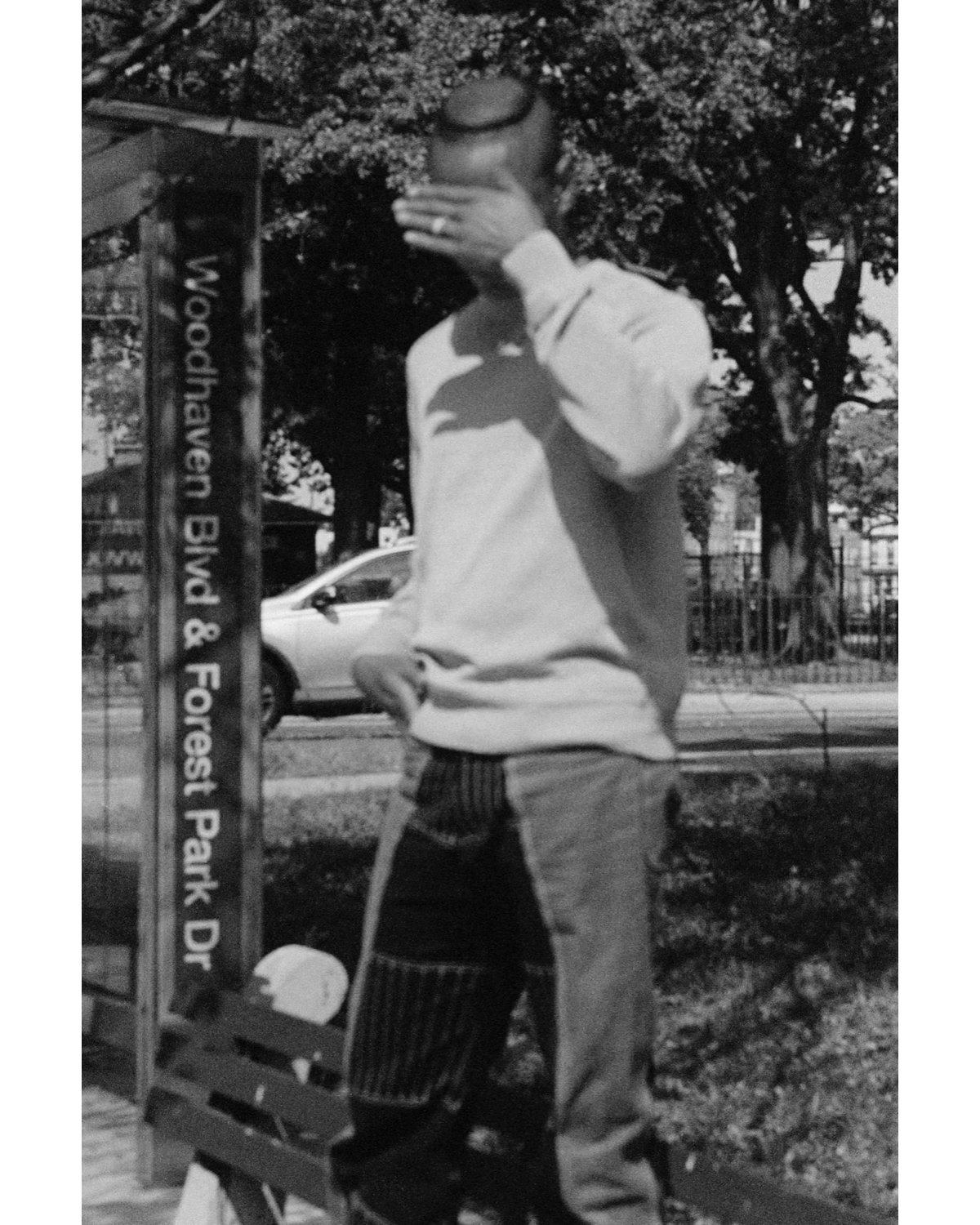
Photograph by Don Brodie
TH: So what are you working on right now that you can reveal to me and the people in Justsmile?
DNM: Nothing. Nothing at all.
TH: - Laughs out loud - (both laugh)
DNM: I'm working on so much, I’m interested in publishing the zine. Some friends of mine have their first book projects and I’m trying to figure out how that goes. As for the next 3 Dot, I have so many ideas about it. It's like I can't say stuff until I know what it is. But I know that the next issue will be the third issue. To me, that's like, it's almost a full circle, and that's a big part of how I think.
I've been playing around with the idea of the Bible in my head, but maybe just in space, as far as like, how much text exists, or how many things exist, not necessarily in like concepts.
Even in paper selection, so like, that's where I'm at mentally, like, I think about the structures of things so intensely that it takes me a long time I have some ideas that I want to go down. I'm also like, making some visual works, some paintings and things, but as they come together,I never know what it is.
So I'm just trying to allow it to be something because I feel like for the first time, I'm comfortable with that.
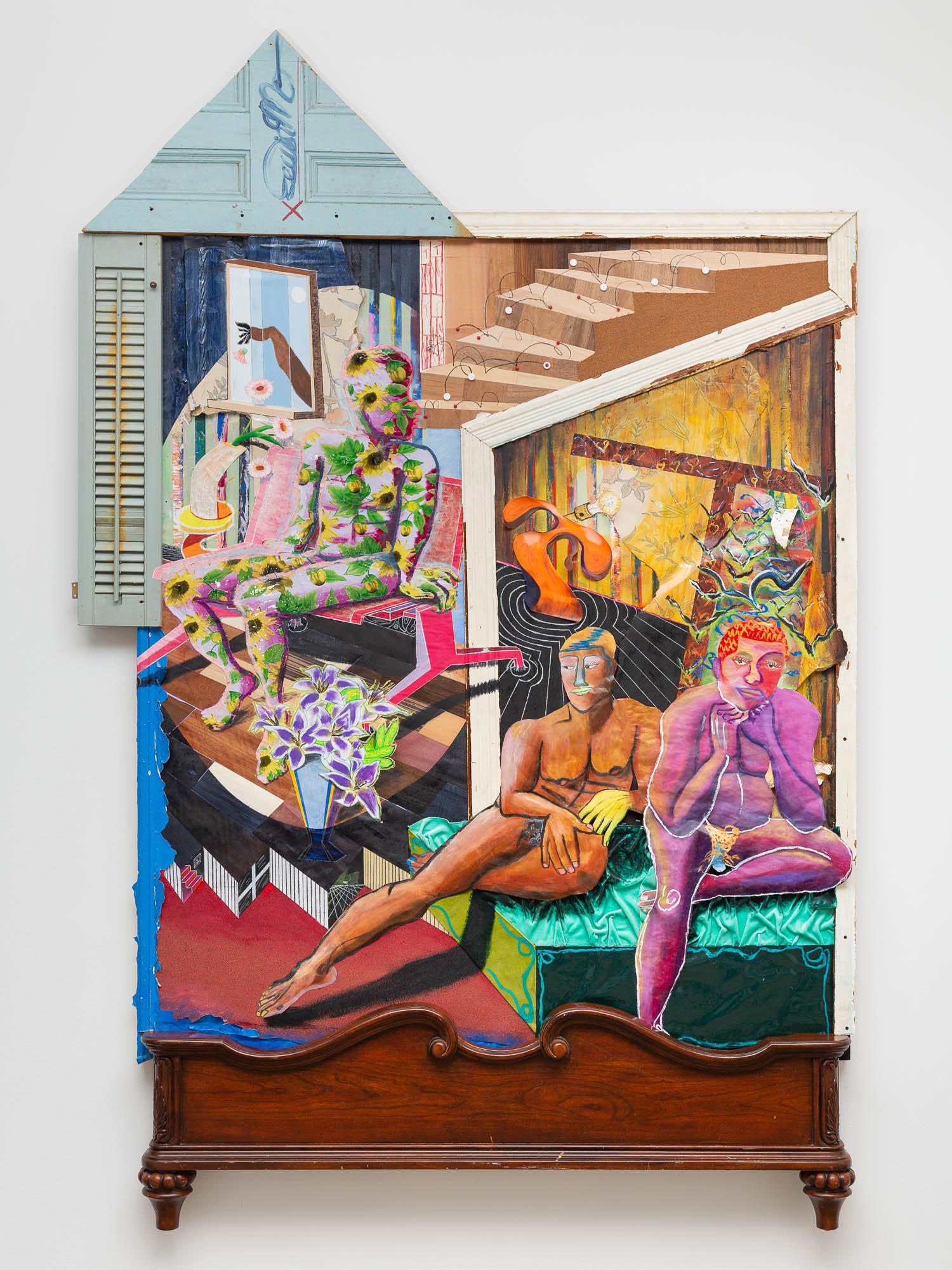
Devin N. Morris 'Water not under the moonlight, water at moon’s eve. Saw it from behind and now the cold front is unveiled, guiltily picked and exposed', 2020
TH: That’s beautiful. You just let it happen. Were you raised religious by any chance? Did you grow up in the church?
DNM: Definitely. My great uncle was the pastor of a church. I grew up in the church. With my granddad and my grandma, or through my mom and her uncle's church. And then on my dad's side, through my grandpa and grandma, they attended a Methodist Church. My granddad was an usher. And that wasn't necessarily my family church, but my grandpa, my grandma, all my aunts, uncles from my brother's, my dad's brothers and sisters went. So I did see that as my other family church.
TH: I ask because I grew up in the church, very Southern and Baptist. I thought it was interesting that you bring up threes, yesterday my friend just sent me a voice message where he was like “ Hey Teri, you were raised religious, you know how, like, similarities between the beginning of the Torah, and beginning of the sacred Islamic texts, which is the same as part of the Bible.” And then he asked “What is the significance of the number three, do people study that?”
DNM: Three seems very based on a lot of causes of spirit and spirituality. Through church or other esoteric means. And in architecture, the strongest structure is the triangle. You need three points to make a circle. Two points is a line, three points is a circle.
My tattoo is just these black dots. I was initially thinking of learning as a cycle. I know that three has some very specific spiritual meanings. But I know it also is like, based in the whole structure of how we see or think.
TH: Now my brain is spinning. How about a less serious question? What is your favorite song of all time?
DNM: I'm not big on favorites. But I will say that growing up Aaron Hall’s I Miss You. It was a song that I really really vibrated with.
I've always kind of been someone who grieves, or someone who has been comfortable with grieving, or close to the idea of loss. I remember growing up loving this song.
My grandmother passed away. I had those very early funeral experiences though I wasn’t, you know fully connected to these women. It was just that I understood something about losing things. So that was my first favorite. And I love so much music now. I can't even.
I think it’s about sound. I don't know if I could tell you a favorite song. But I could tell you a new favorite sound in a song, you know? Like the last song in Solange’s latest project.
TH: Yeah, When I Get Home.
DNM: I don't know if it's bass or whatever. The one that starts ‘“you can work through me”.
(Note - The song Morris is referring to is ‘I’m A Witness’)
All the notes of that beginning of that song, I literally can just replay the beginning of that song over and over and over again.
There's normally sounds that I get obsessed with, then I have to hear a song to get to that sound.
Gospel music is often like that. Yesterday I went back to Kirk Franklin’s ‘Rebirth,’ which is this one that plays a lot of sounds I like.
In the Dreamgirls soundtrack when they come back together at the end and they allow Jennifer Hudson's character to lead and Beyoncé and everybody's in the background. I love Beyoncé and Beyoncé came from Destiny’s Child, one of the greatest harmonizing groups. So, Beyoncé in harmony behind Jennifer in that and with Anika Noni Rose, that was mind blowing. And then Beyoncé ends it. Jennifer sounded so amazing they’re behind her ‘there…’ and then at the end, Beyoncé is that soprano and she's the last ‘there’ note in the song -- her voice is slightly above and it's just heaven.
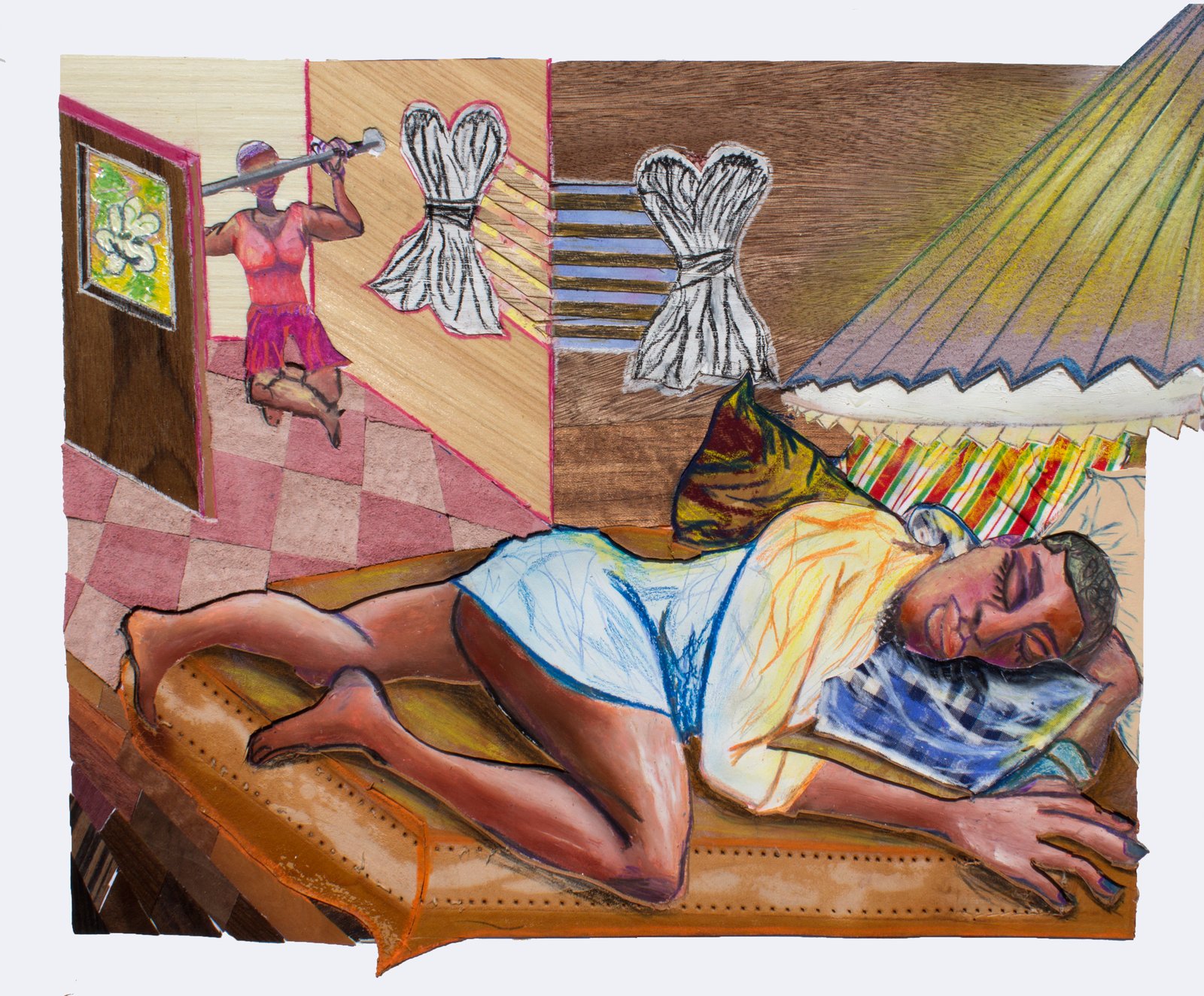
Devin N. Morris 'Birds Through A Window Chirp Frying Flying Chicken Grease Glittered Air. Intarsia 4', 2020
TH: So, congratulations on your show Noplace at PPOW Gallery.
DNM: Yeah, that was a group show that Eden Deering curated.
TH: It looked beautiful. I looked through the installation photos online and the chair objects immediately caught my attention, which brings me to my next question and, is something that I have always wondered, what is the significance of chairs in your work?
DNM: I think it's about presence. In my last solo exhibition, which was Play Too Much at Company Gallery, the chairs were... I didn't know what they were. For 10 years I had just been acquiring them and had them all in my house, about 30 of them.
In old photographs of designers, in the ateliers, the fashion designers, they would have a room that was just full of chairs all along the wall, which was also an event space at the end of the night too.
So there are chairs along the wall, and they clear the center. I like something about that. So that was the first thing I was thinking about with selecting chairs.
Then over time I started to think about how humans behave with objects. We know how to socialize them. We say a chair, you think it's supposed to hold you up, you can sit in it, and sometimes it might help you or it might remind you of something or it can even feel like a presence, like a presence is there.
So when I put that grouping at Play Too Much in center, I remember feeling initially like it was a church. It was like church pews the first way I set it up.
I think I’m often trying to visualize transcendence. Some things can feel too grounded in the physical, like chairs.I was attracted to chairs, but then I started to move to other objects domestically.
In Noplace, the sculpture piece that has the three doors. I was thinking about a curtain. I was trying to have windows, they’re powerful because no matter what kind of place you’re in, you know that a window helps to see through to another place.
That other place sometimes being what you need to play, the imagination of that, the knowing that it's possible to be further than where you are. That means that you might be living within or like situated within at a moment, but that you're not limited to that.
And then the work I'm about to describe is the white chair within the heads of vases of lilies that kind of blossom and then die throughout the process of showing the work. I'm looking at that more as an alternative, there is a book that James Baldwin had collaborated on with Richard Avedon. And it's called, Nothing Personal. Personally, I'm not fully interested in the relationship with Richard and James, but I'm interested in that statement, ‘nothing personal.’
So the chair that's used in that space is white, and then the flowers are also white. The work is titled then strained to hear you hear you above the noise out there.
It’s a gated area, a gated off like living space, some kind of interior space with these exterior door objects.
I think that work was made in 2019. I think about that work as a kind of conversational piece between the matriarch and patriarch of my family. I was trying to deal with this relationship between the duties I learned inside the home from like my grandmother, and in the duties that are particularly from my granddad, which were like domestic care.
I feel like there's a lot of ancestral, knowledge in it.It doesn't have a lot to do with actually being clean. But it has a lot to do with clarity, so that you're always welcoming in what you need. It’s kind of a spiritual practice to be cleanly. Or to take care of family.
I was also trying to recognize, to reckon with the idea that there's a difference between like a woman's work or a man’s work -- it's like all work is work, work has to be done.
That was me starting this process of breaking down love in a way.
Then the two chair objects in there are built were these two sculptures. One is like this pink lounge thing that kind of looks like a tongue lashing out, it's suspended on a door opposite a heavier brown leather chair. They're in communication.
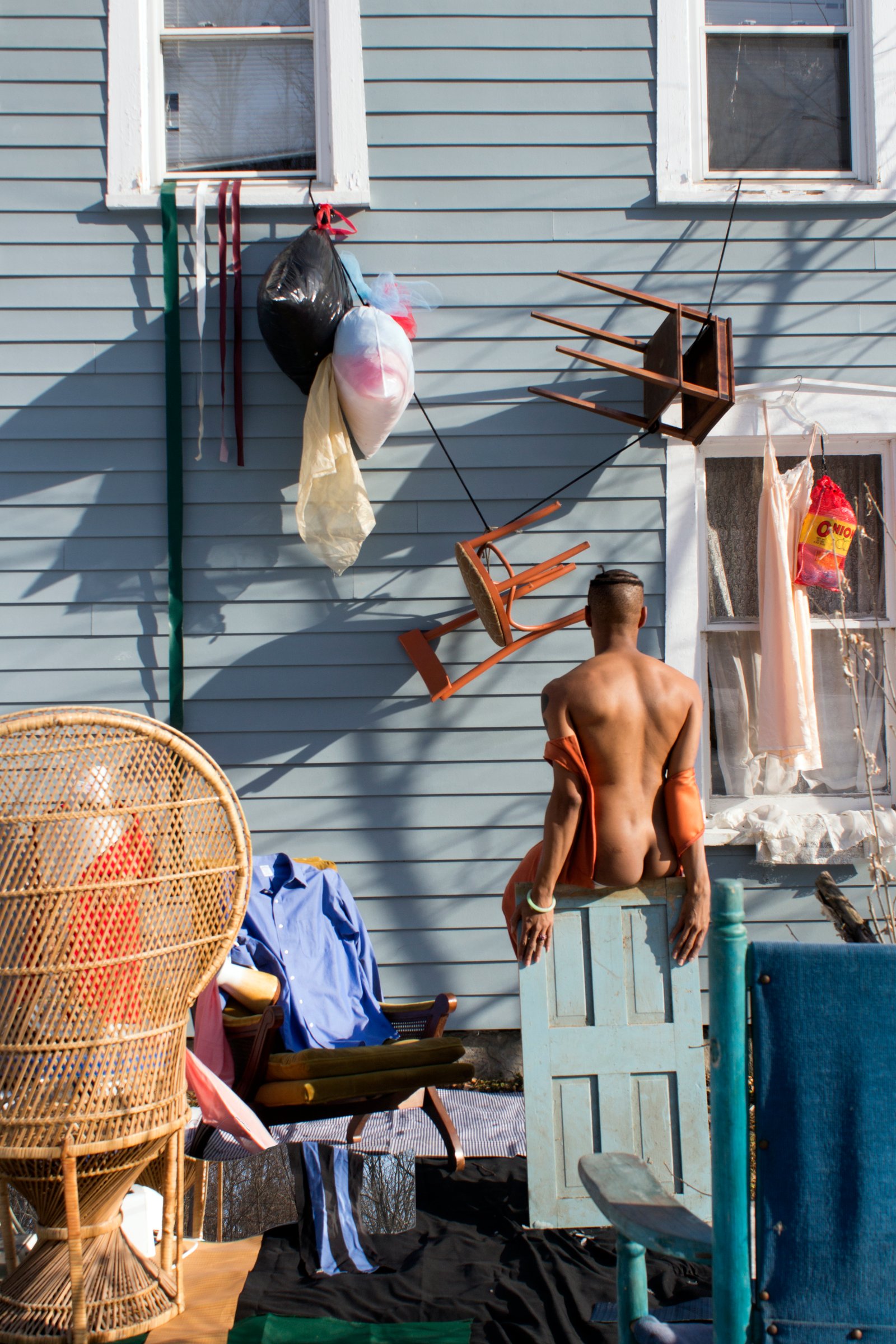
Devin N. Morris 'Homeostatic', 2020
TH: Today I was thinking about when I installed the piece that we used for ANOTHER COUNTRY. When I unpacked the work I remember thinking that you gave these really detailed instructions. I was struck by your level of intention. I really appreciated your energy in that moment. It was a very chaotic time right before stay at home orders were implemented. I remember unrolling the piece and being in awe. I said ‘this thing is so beautiful in real life’ because I had only seen the work online. I was on cloud nine, and then assembling the piece based on your instructions, I just remember the level of detail. I love the yellow material, is it wallpaper?
DNM: I wanted it to look like a wall that I'd cut. And then a wall has a window, which looks into a small room and then a chair that is somehow in between space.
There’s a figure in the door, you know, it can get a little heavy, But I did like that kind of personal-ness of that. It was this big space that kept getting smaller and getting more vulnerable.
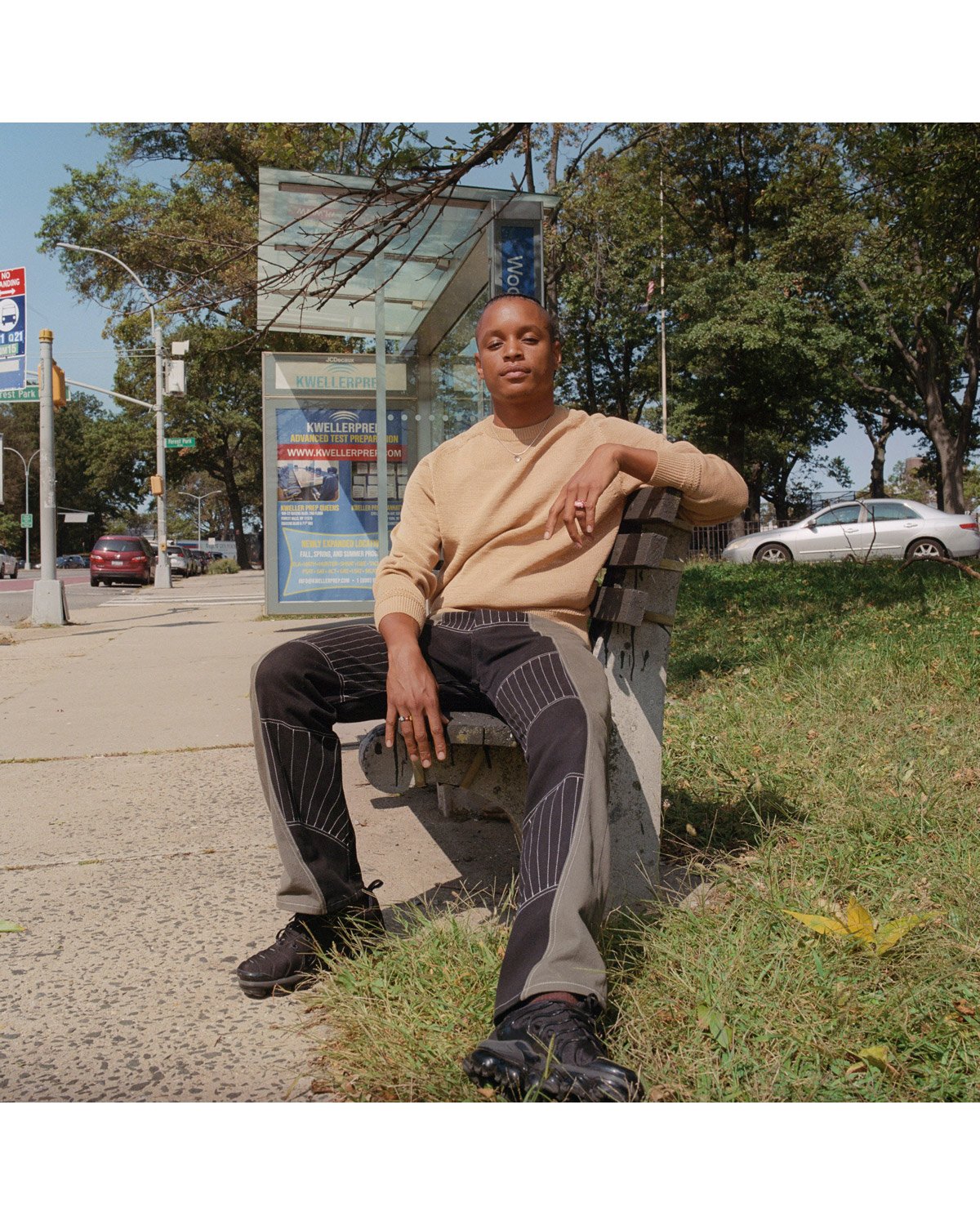
Photograph by Don Brodie
TH: I’ve been researching a lot about Black collage artists and I keep coming back to your work. How would you categorize your practice?
DNM: I think that my work definitely starts in poetry and collage.
Even as I start to think, I think through objects that I'm finding and working with. I love doors and I have so many windows, so many things that I keep picking up. I like to think of these objects as becoming vulnerable. But you know, if I think of them as what they are, sometimes then it feels like there's a limit.
I have to think of objects as surfaces that will then be collaged, not is the door a door, or is the chair a chair. Instead, this surface will be maneuvered as material is maneuvered to do whatever the material needs to do.
So yeah, I think the work is fully based on collage as it goes across video, photography, these kinds of things. I don't fully think of my identity as being collage.
But I do know that a lot of what I've learned through these ancestral, passed down kinds of care acts is: with what you have, you can make what you need. So that's how I look at collage as being like this kind of practice of like, ‘no matter what I have, I can kind of make the thing I need,’ because that's how I learned how to cook. And that's how I learned pretty much everything.
‘I don't always look at something as inspiring. I look at things as freedom based. Seeing mistakes or seeing certain things in people’s work and being like, 'Oh, that's a freedom that maybe I wasn't thinking I could take.'’
TH: Tell me a little about what you hope next year will look like for yourself personally, and for all of us politically.
DNM: Personally I'm interested in making things; I'm not necessarily interested in socializing them.
I don't really want to have to be in too many social relationships around my art. But I am interested in quietly making things. So being more intentional, more quiet, and being more caring to myself and to others. And then politically for everybody, I don’t know. Like, come on now. All these dreams of politics. Get out of here, there's no beauty in what I see in the future, but I do feel that we'll know when we know.
TH: Whose work influences your own?
DNM: I don't always look at something as inspiring. I look at things as freedom based. Seeing mistakes or seeing certain things in people’s work and being like, ‘Oh, that's a freedom that maybe I wasn't thinking I could take.’
